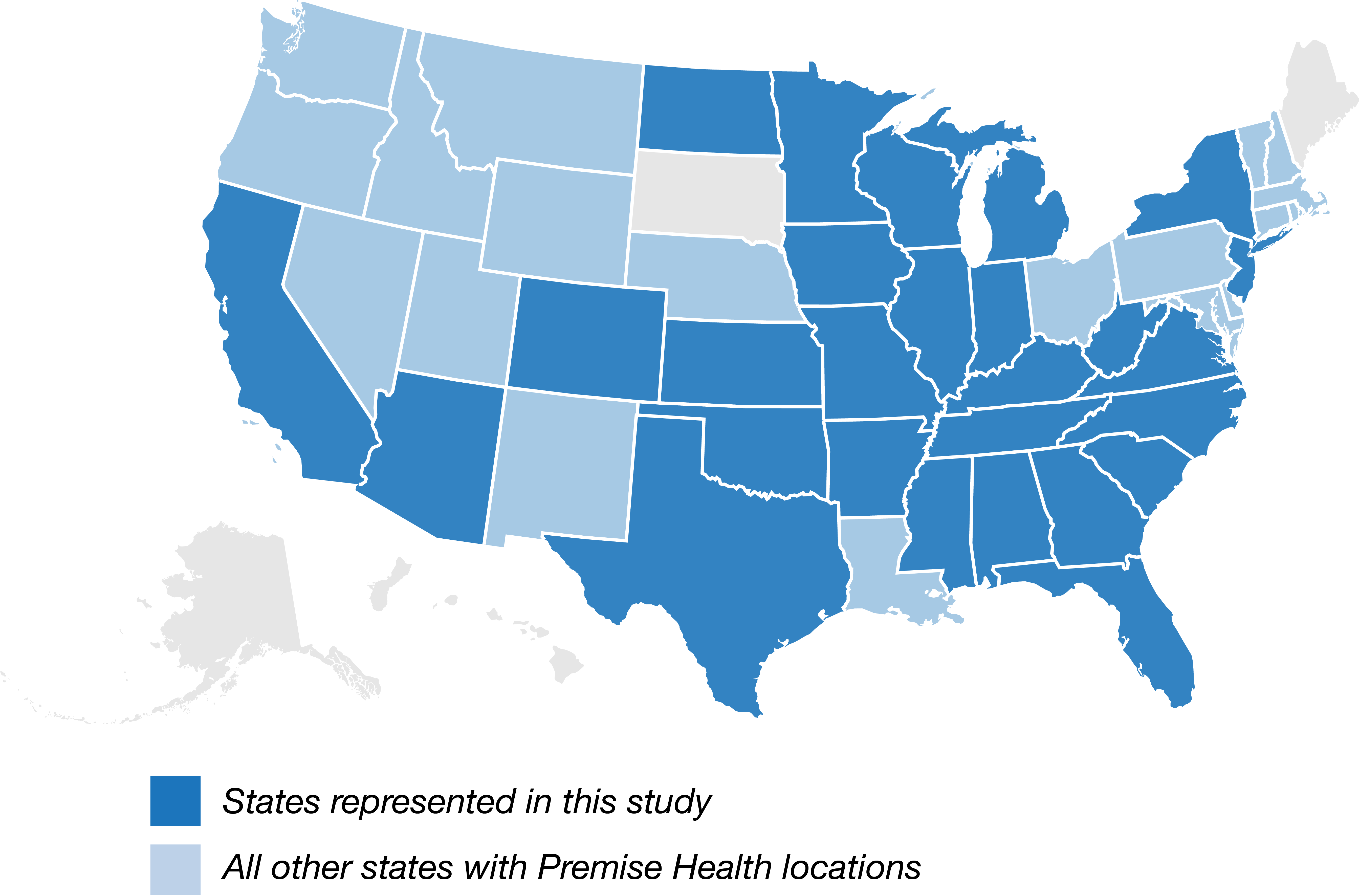New study finds advanced primary care with Premise Health saves employers and unions 30% on total healthcare costs for attributed members
Each year, employers and unions make decisions about what healthcare benefits to offer. They face some grim trends. Insurance premiums have increased 47%1 since 2013. One in three Americans are without a primary care provider2, and the number of people managing a chronic condition has gone up.
Healthcare costs are climbing, while people are getting sicker. Is this the future, or is there a better way?
For many organizations, it’s time for a different approach: advanced primary care. This model makes primary care the foundation, so healthcare starts to work the way it should. In a recent claims-based analysis of over 207,000 lives across 26 employers and unions, the results show advanced primary care leads to better health and lower healthcare costs.
The study showed that advanced primary care led to:
| 20% | increase in routine, preventive, and mental health office visits |
| 17% | reduction in emergency room visits |
| 52% | reduction in inpatient hospital admissions |
By providing easy access to primary care when and where their members needed it, health issues were addressed earlier and there were fewer costly emergency room visits and hospital admissions, which saved money for both clients and members.
The Findings
A representative, claims-based analysis by Premise Health showed employers and unions save an average of 30%, or $2,434, on the total cost of care for members and dependents attributed to a Premise onsite or nearsite wellness center, compared to those members and dependents who access care in their communities. The study, which was based on approximately 207,000 eligible lives, represents one of the largest sample sizes ever assessed in the direct healthcare industry. It was conducted by Premise using a methodology validated by Milliman, an internationally recognized actuarial and consulting firm, for reasonableness, appropriateness, and actuarial soundness.
Premise achieved these savings by providing members and dependents with high-quality, cost-effective healthcare in a primary care setting. This is the second year of the study using the validated methodology, and data from both years has shown a clear message. Premise’s onsite and nearsite advanced primary care leads to more preventive care and better health, which reduces expensive and preventable care that members are paying for in the community. This resulted in savings for employers, unions, and families.
More Care = More Savings
While all organizations in the study benefitted from offering onsite and nearsite primary care, some saw higher savings than others. Those with some of the greatest total cost of care savings, 47%, or $3,254, suggest these results are achievable by implementing several strategies:

Boosting engagement and utilization of their wellness centers.
While each organization took a unique approach based on their population, some of the most influential keys to success included: hosting marketing events to promote the center, providing an eligibility file with contact information to enable member outreach and engagement, offering multiple access options, and incentivizing use of their wellness center through low or $0 co-pays.
Offering primary care and at least one additional type of care.
The study found bringing together primary care with virtual primary care, behavioral health, pharmacy, Care Management, and/or Care Navigation resulted in better engagement, positive health outcomes, and higher cost savings than the community. Primary care on its own is powerful, but the organizations that offered the most comprehensive care saw the greatest savings.
Providing Premise safe and secure access to their claims data.
This information allows Premise care teams to proactively identify and care for high-risk members who are driving most of employers’ and unions’ healthcare spend. Data-driven insights also support more equitable care by identifying members who have experienced barriers to care in the past so providers can help them overcome those challenges. The findings show that data enables better member care.
After years of rising healthcare costs, with a Business Group on Health survey projecting an 8% increase in 2025, and declining health, organizations are realizing the importance of prioritizing accessible, high-quality primary care for their people. By taking charge and pursuing a different approach to care, organizations can avoid sky-high healthcare costs and provide a better experience for their members. When their people are healthier, they can thrive.
The Study
The study compared a cohort of employees or union members and their dependents who were attributed to a Premise wellness center to those attributed to a community provider. Attribution is determined by where someone receives most of their primary care, pharmacy, and/or behavioral health services and is based on visit frequency, not cost. Compared to 2022, the 2023 study saw a 14% increase in average attribution due to organic business growth and a larger sample size. In addition, Premise has launched an initiative to raise member awareness of their wellness center benefits over the past year, which has successfully increased attribution.
The analysis looked at data from medical claims, prescription drug claims, and community claims to evaluate risk-adjusted health outcomes and cost of care over a 12-month period. Total cost of care per community-attributed member was then risk-adjusted to compare Premise-attributed members to a similar cohort of community-attributed members.
26 self-insured employers and unions
Average eligible population of 8,000
Average attribution rate of 58%
Average engagement rate of 29%
Average Premise-attributed member savings of $2,434
Average client tenure of five years
Industries represented:
> Manufacturing
> Finance and Insurance
> Healthcare
> Retail
> Utilities
> Wholesale
> Public Administration
> Agriculture
> Rental and Leasing
> Software and Tech
> Labor Union
The Methodology
Premise leveraged its Milliman-validated methodology for measuring total cost of care savings and calculating return on investment (ROI). For this year’s study, the methodology was extended to evaluate the impact of behavioral health, and recommendations from Milliman were implemented for Care Management program data. In addition, Premise partnered with health data analytics company Cedar Gate Technologies to intake and prepare the data for this study.
The use of independent third parties to validate an appropriate methodology for estimating the impact (Milliman) and perform complex analysis on large datasets (Cedar Gate) was critical to accurately measuring the value that employers, unions, and risk-bearing organizations can receive from onsite and nearsite wellness centers.
To access a full report from Milliman on this methodology, click here.
A claims-based analysis of 26 organizations and unions from 11 industries demonstrated 30% savings on employees’ and union members’ total cost of care across varied markets.

1Kaiser Family Foundation. 2023 Employer Health Benefits Survey. October 18, 2023. Available at: https://www.kff.org/report-section/ehbs-2023-section-1-cost-of- health-insurance/
2National Association of Community Health Centers. Closing the Primary Care Gap: How Community Health Centers Can Address the Nation’s Primary Care Crisis. February 2023. Available at: https://www.nachc.org/wp-content/uploads/2023/06/ Closing-the-Primary-Care-Gap_Full-Report_2023_digital-final.pdf


